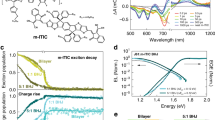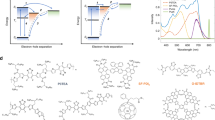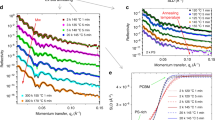Abstract
Blends of conjugated polymers with fullerenes, polymers, or nanocrystals make promising materials for low-cost photovoltaic applications. Different processing conditions affect the efficiencies of these solar cells by creating a variety of nanostructured morphologies, however, the relationship between film structure and device efficiency is not fully understood. We introduce time-resolved electrostatic force microscopy (EFM) as a means to measure photoexcited charge in polymer films with a resolution of 100 nm and 100 μs. These EFM measurements correlate well with the external quantum efficiencies measured for a series of polymer photodiodes, providing a direct link between local morphology, local optoelectronic properties and device performance. The data show that the domain centres account for the majority of the photoinduced charge collected in polyfluorene blend devices. These results underscore the importance of controlling not only the length scale of phase separation, but also the composition of the domains when optimizing nanostructured solar cells.
This is a preview of subscription content, access via your institution
Access options
Subscribe to this journal
Receive 12 print issues and online access
$259.00 per year
only $21.58 per issue
Buy this article
- Purchase on Springer Link
- Instant access to full article PDF
Prices may be subject to local taxes which are calculated during checkout




Similar content being viewed by others
References
Nelson, J. Solar energy—Solar cells by self-assembly? Science 293, 1059–1060 (2001).
Shaheen, S. E., Ginley, D. S. & Jabbour, G. E. Organic-based photovoltaics. toward lowm-cost power generation. Mater. Res. Soc. Bull. 30, 10–19 (2005).
Hoppe, H. & Sariciftci, N. S. Organic solar cells: An overview. Mater. Res. Soc. Bull. 19, 1924–1945 (2004).
Gregg, B. A. The photoconversion mechanism of excitonic solar cells. Mater. Res. Soc. Bull. 30, 20–22 (2005).
Halls, J. J. M. et al. Efficient photodiodes from interpenetrating polymer networks. Nature 376, 498–500 (1995).
Yu, G., Gao, J., Hummelen, J. C., Wudl, F. & Heeger, A. J. Polymer photovoltaic cells—enhanced efficiencies via a network of internal donor-acceptor heterojunctions. Science 270, 1789–1791 (1995).
Chirvase, D., Parisi, J., Hummelen, J. C. & Dyakonov, V. Influence of nanomorphology on the photovoltaic action of polymer-fullerene composites. Nanotechnology 15, 1317–1323 (2004).
Padinger, F., Rittberger, R. S. & Sariciftci, N. S. Effects of postproduction treatment on plastic solar cells. Adv. Funct. Mater. 13, 85–88 (2003).
van Duren, J. K. J. et al. Relating the morphology of poly(p-phenylene vinylene)/methanofullerene blends to solar-cell performance. Adv. Funct. Mater. 14, 425–434 (2004).
Kim, Y. et al. A strong regioregularity effect in self-organizing conjugated polymer films and high-efficiency polythiophene: fullerene solar cells. Nature Mater. 5, 197–203 (2006).
Snaith, H. J., Arias, A. C., Morteani, A. C., Silva, C. & Friend, R. H. Charge generation kinetics and transport mechanisms in blended polyfluorene photovoltaic devices. Nano Lett. 2, 1353–1357 (2002).
Arias, A. C. et al. Photovoltaic performance and morphology of polyfluorene blends: A combined microscopic and photovoltaic investigation. Macromolecules 34, 6005–6013 (2001).
Moons, E. Conjugated polymer blends: linking film morphology to performance of light emitting diodes and photodiodes. J. Phys. Condens. Matter 14, 12235–12260 (2002).
Coakley, K. M., Liu, Y. X., Goh, C. & McGehee, M. D. Ordered organic-inorganic bulk heterojunction photovoltaic cells. Mater. Res. Bull. 30, 37–40 (2005).
Coffey, D. C. & Ginger, D. S. Patterning phase separation in polymer films with dip-pen nanolithography. J. Am. Chem. Soc. 127, 4564–4565 (2005).
McNeill, C. R., Frohne, H., Holdsworth, J. L. & Dastoor, P. C. Near-field scanning photocurrent measurements of polyfluorene blend devices: Directly correlating morphology with current generation. Nano Lett. 4, 2503–2507 (2004).
Chappell, J. et al. Correlating structure with fluorescence emission in phase-separated conjugated-polymer blends. Nature Mater. 2, 616–621 (2003).
McNeill, J. D. & Barbara, P. F. NSOM investigation of carrier generation, recombination, and drift in a conjugated polymer. J. Phys. Chem. B 106, 4632–4639 (2002).
Stevenson, R. et al. Fluorescence scanning near-field optical microscopy of polyfluorene composites. J. Microsc.-Oxford 202, 433–438 (2001).
Cadby, A., Dean, R., Fox, A. M., Jones, R. A. L. & Lidzey, D. G. Mapping the fluorescence decay lifetime of a conjugated polymer in a phase-separated blend using a scanning near-field optical microscope. Nano Lett. 5, 2232–2237 (2005).
DeAro, J. A., Moses, D. & Buratto, S. K. Near-field photoconductivity of stretch-oriented poly(para-phenylene vinylene). Appl. Phys. Lett. 75, 3814–3816 (1999).
Riehn, R. et al. Local probing of photocurrent and photoluminescence in a phase-separated conjugated-polymer blend by means of near-field excitation. Adv. Funct. Mater. 16, 469–476 (2006).
McNeill, C. R. & Dastoor, P. C. Photocurrent pattern formation in polymer/methanofullerene blends imaged by near-field scanning photocurrent microscopy. J. Appl. Phys. 99, 033502 (2006).
Chiesa, M. et al. Correlation between surface photovoltage and blend morphology in polyfluorene-based photodiodes. Nano Lett. 5, 559–563 (2005).
Hoppe, H. et al. Kelvin probe force microscopy study on conjugated polymer/fullerene bulk heterojunction organic solar cells. Nano Lett. 5, 269–274 (2005).
Russell, D. M. et al. Efficient light harvesting in a photovoltaic diode composed of a semiconductor conjugated copolymer blend. Appl. Phys. Lett. 80, 2204–2206 (2002).
Koster, L. J. A., Smits, E. C. P., Mihailetchi, V. D. & Blom, P. W. M. Device model for the operation of polymer/fullerene bulk heterojunction solar cells. Phys. Rev. B 72, 085205 (2005).
Burgi, L., Richards, T. J., Friend, R. H. & Sirringhaus, H. Close look at charge carrier injection in polymer field-effect transistors. J. Appl. Phys. 94, 6129–6137 (2003).
Silveira, W. R. & Marohn, J. A. Microscopic view of charge injection in an organic semiconductor. Phys. Rev. Lett. 93, 116104 (2004).
Burgi, L., Richards, T., Chiesa, M., Friend, R. H. & Sirringhaus, H. A microscopic view of charge transport in polymer transistors. Synth. Met. 146, 297–309 (2004).
Palermo, V., Palma, M. & Samori, P. Electronic characterization of organic thin films by Kelvin probe force microscopy. Adv. Mater. 18, 145–164 (2006).
Muller, E. M. & Marohn, J. A. Microscopic evidence for spatially inhomogeneous charge trapping in pentacene. Adv. Mater. 17, 1410–1414 (2005).
Ramsdale, C. M. et al. The origin of the open-circuit voltage in polyfluorene-based photovoltaic devices. J. Appl. Phys. 92, 4266–4270 (2002).
Ramsdale, C. M. et al. ESEM imaging of polyfluorene blend cross-sections for organic devices. Physica E 14, 268–271 (2002).
Snaith, H. J., Greenham, N. C. & Friend, R. H. The origin of collected charge and open-circuit voltage in blended polyfluorene photovoltaic devices. Adv. Mater. 16, 1640–1645 (2004).
Arias, A. C. et al. Vertically segregated polymer-blend photovoltaic thin-film structures through surface-mediated solution processing. Appl. Phys. Lett. 80, 1695–1697 (2002).
Tevaarwerk, E., Keppel, D. G., Rugheimer, P., Lagally, M. G. & Eriksson, M. A. Quantitative analysis of electric force microscopy: The role of sample geometry. Rev. Sci. Instrum. 76, 053707 (2005).
Koster, L. J. A., Mihailetchi, V. D., Ramaker, R. & Blom, P. W. M. Light intensity dependence of open-circuit voltage of polymer: fullerene solar cells. Appl. Phys. Lett. 86, 123505 (2005).
Morteani, A. C., Friend, R. H. & Silva, C. Exciton trapping at heterojunctions in polymer blends. J. Chem. Phys. 122, 244906 (2005).
Barker, J. A., Ramsdale, C. M. & Greenham, N. C. Modeling the current-voltage characteristics of bilayer polymer photovoltaic devices. Phys. Rev. B 67, 075205 (2003).
Tanase, C., Meijer, E. J., Blom, P. W. M. & de Leeuw, D. M. Unification of the hole transport in polymeric field-effect transistors and light-emitting diodes. Phys. Rev. Lett. 91, 216601 (2003).
Bucknall, D. G. Influence of interfaces on thin polymer film behaviour. Prog. Mater. Sci. 49, 713–786 (2004).
McNeill, C. R. et al. Nanoscale quantitative chemical mapping of conjugated polymer blends. Nano Lett. 6, 1202–1206 (2006).
Acknowledgements
We thank O. Reid and Y. Chen for their experimental assistance, Asylum Research for their continuing help, M. Chiesa and R. Shikler for their comments on the manuscript and H. Snaith for his comments and for valuable discussions. This material is based on work supported by the National Science Foundation (DMR 0449422) and the STC Program of the National Science Foundation (DMR 0120967).
Author information
Authors and Affiliations
Corresponding author
Ethics declarations
Competing interests
The authors declare no competing financial interests.
Supplementary information
Supplementary Information
Supplementary figures S1-S8 (PDF 5514 kb)
Rights and permissions
About this article
Cite this article
Coffey, D., Ginger, D. Time-resolved electrostatic force microscopy of polymer solar cells. Nature Mater 5, 735–740 (2006). https://doi.org/10.1038/nmat1712
Received:
Accepted:
Published:
Issue Date:
DOI: https://doi.org/10.1038/nmat1712
This article is cited by
-
Learning the right channel in multimodal imaging: automated experiment in piezoresponse force microscopy
npj Computational Materials (2023)
-
Understanding the evolution of lithium dendrites at Li6.25Al0.25La3Zr2O12 grain boundaries via operando microscopy techniques
Nature Communications (2023)
-
High-speed mapping of surface charge dynamics using sparse scanning Kelvin probe force microscopy
Nature Communications (2023)
-
A dual-use probe for nano-metric photoelectric characterization using a confined light field generated by photonic crystals in the cantilever
Nano Research (2021)
-
New type of doping effect via metallization of surface reduction in SnO2
Scientific Reports (2019)



